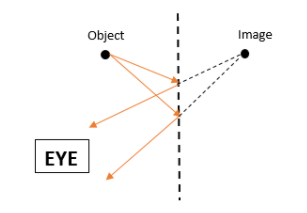
A plane mirror:
(i) Can form a real image of a real object.
(ii) Neither converges or diverges the rays.
(iii) Cannot form a real image of a real object.
Choose the correct option or options.
A. (i) is correct.
B. (i) and (ii) are correct.
C. (ii) and (iii) are correct.
D. None of the above.
Answer
554.4k+ views
Hint: A flat mirror that has a smooth surface is called a plane mirror. Plane mirrors form virtual and upright images that are of the same size as the object. The focal length of a plane mirror is infinity, hence, it neither converges or diverges the rays.
Complete answer:
A plane mirror forms images on the other side of the mirror. The distance of the image behind the mirror appears to be the same as the distance of the object in front of the mirror. This is because the light rays appear to reflect off from the image. However, in reality, the light is reflected from the surface of the mirror. An image is perceived even though no light rays actually pass through the image. Hence, the image is virtual. A diagram can be illustrated as follows:

Also, a plane mirror can form images of objects kept at any distance from the mirror. Therefore, the focal length of the plane mirror is infinite and hence, it neither converges or diverges the rays.
The answer is option C.
Note:
Real images are formed when light rays converge to form the image. Only concave mirrors can form real images.
Even though the image formed by a plane mirror is upright, it is laterally inverted. In other words, the left and right sides of an object are reversed in the image formed by a plane mirror.
Complete answer:
A plane mirror forms images on the other side of the mirror. The distance of the image behind the mirror appears to be the same as the distance of the object in front of the mirror. This is because the light rays appear to reflect off from the image. However, in reality, the light is reflected from the surface of the mirror. An image is perceived even though no light rays actually pass through the image. Hence, the image is virtual. A diagram can be illustrated as follows:

Also, a plane mirror can form images of objects kept at any distance from the mirror. Therefore, the focal length of the plane mirror is infinite and hence, it neither converges or diverges the rays.
The answer is option C.
Note:
Real images are formed when light rays converge to form the image. Only concave mirrors can form real images.
Even though the image formed by a plane mirror is upright, it is laterally inverted. In other words, the left and right sides of an object are reversed in the image formed by a plane mirror.
Recently Updated Pages
Master Class 12 Business Studies: Engaging Questions & Answers for Success

Master Class 12 Social Science: Engaging Questions & Answers for Success

Master Class 12 English: Engaging Questions & Answers for Success

Master Class 12 Chemistry: Engaging Questions & Answers for Success

Class 12 Question and Answer - Your Ultimate Solutions Guide

Master Class 12 Economics: Engaging Questions & Answers for Success

Trending doubts
What are the major means of transport Explain each class 12 social science CBSE

Which are the Top 10 Largest Countries of the World?

Draw a labelled sketch of the human eye class 12 physics CBSE

How much time does it take to bleed after eating p class 12 biology CBSE

Explain sex determination in humans with line diag class 12 biology CBSE

Differentiate between homogeneous and heterogeneous class 12 chemistry CBSE




